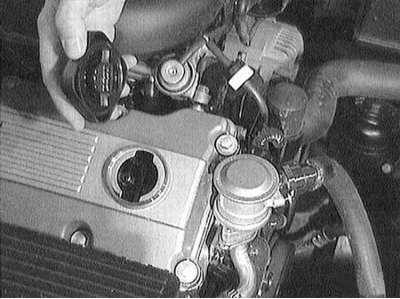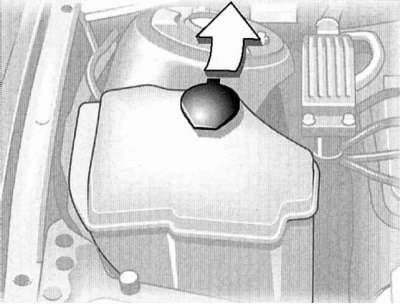The procedures for checking the fluid level are described below, carried out every 400 km or weekly. A description of other fluid level checks can be found later in the Sections on specific maintenance procedures. Regardless of the scheduled inspection intervals, do not allow fluid to leak under the vehicle, such leaks indicate a malfunction that should be repaired immediately.
Examination

1. Fluids are an integral part of the lubrication, cooling, brake and windshield washer systems. Due to the gradual consumption and / or contamination of fluids during normal vehicle operation, they should be replaced periodically. Check out Section "Types and volumes of lubricants and fluids used" See the Specifications before adding fluid to any of the listed components.
Whenever checking the fluid level, the vehicle must be on a level surface.
Engine oil
2. Checking the level of impellent oil is carried out using a dipstick located on the side of the engine (refer to the illustrations of the engine compartment given in this chapter to determine its location). The dipstick goes down through the metal tube to reach the bottom of the engine sump.
3. Measuring the level of impellent oil is carried out before starting the engine or at least 15 minutes after it is turned off.
If you start measuring the engine oil level immediately after turning off the engine, some of the oil will remain in the upper part of the engine, which will significantly affect the accuracy of the dipstick readings.

4. Remove the probe and dry the blade with a clean cloth or paper towel. Insert the dipstick all the way back and remove it again. The height of the oiled section of the blade will match the oil level in the engine. This level should be between the two marks on the dipstick.
5. One liter of oil is required to raise the oil level from the minimum mark on the dipstick to the maximum mark. Do not allow the level to fall below the minimum mark, as oil starvation can damage the engine. On the other hand, overfilling the engine with oil (topping up above the maximum mark) can cause clogged spark plugs, oil leaks, or seal failure.

6. To add oil, unscrew the filler cap located on the cylinder head cover. After adding oil, wait a few minutes for the oil level to stabilize, then remove the dipstick and check the level again. Add more oil if required. Close the filler cap and tighten it by hand.
7. Checking the oil level is an important preventive measure. The engine should not consume more than 0.7 liters of oil per 1,000 kilometers. A persistent drop in oil level indicates either oil leaks from damaged seals or loose connections, or it is burning out (internal leaks through worn piston rings or through valve guides). In addition, you should pay attention to the condition of the oil itself. If the oil has a milky color or you can see drops of water in its composition, this indicates a possible leak in the cylinder head gasket or a crack in the cylinder head or block. In this case, the engine should be repaired immediately. Each time you check the oil level, run your thumb and forefinger over the dipstick blade before wiping. If dirt particles or metal particles are found adhering to the dipstick, the oil should be changed (refer to Section Changing the engine oil and oil filter).
Engine cooler
Do not allow antifreeze to come into contact with your skin or painted vehicle surfaces. If this does happen, rinse off the antifreeze immediately with plenty of water. Antifreeze is extremely toxic if ingested. Never leave it unattended in an open container or spilled on the floor; children or animals may be attracted to its sweet smell and drink it. Arrange with local authorities to dispose of used antifreeze.
8. All vehicles covered in this manual are equipped with an overpressure compensation type cooling system. Expansion tank (or coolant tank) located in the engine compartment and connected to the radiator. As the engine warms up during operation, the expanding coolant fills the reservoir. When the engine cools down, the coolant automatically flows back into the cooling system, which maintains a constant value of its level.
9. Coolant level should be checked regularly. Loosen the cap on the expansion tank. The fluid level is normal when the engine is cold (coolant temperature +20°C) the upper edge of the red float is at the same height as the edge of the filling nozzle. If the fluid level is low, add fluid. Add coolant only when the engine is cold to prevent damage.
Do not remove the filler cap of the expansion tank or the radiator cap to check the coolant level before the engine has completely cooled down! The level in the reservoir fluctuates depending on the temperature of the engine.
10. Run the car and measure the coolant level again. If only a small amount of coolant needs to be added to the correct level, clean water can be used for this. However, frequent additions of water will dilute the antifreeze. In order to ensure the correct ratio of antifreeze and water, always top up to the correct level with the required mixture.
11. If the coolant level drops regularly, there may be a leak in the system. Inspect the radiator, hoses, filler cap, drain plugs and water pump. If no leaks are found, have the expansion tank cap and radiator cap leak tested at a BMW workshop.
12. If you need to remove the cover, wait until the engine is completely cool, then wrap a piece of thick rag around the cover and unscrew it to the first stop. If steam or coolant starts to escape from the cover, allow the engine to cool slightly before removing the cover.
13. It is also necessary to check the condition of the cooler. It should be relatively clean. If the fluid is brown or rusty in color, it must be drained, the system flushed and filled with new mixture. Even if the coolant looks normal, the corrosion inhibitors it contains lose their effectiveness over time, so it should be replaced at regular intervals.

14. To check the frost resistance of the coolant, you must use a hydrometer (see also Section Checking the functioning of the cooling system and frost resistance of the coolant). Draw coolant with a bulb and read the float. To ensure frost resistance down to -35°C, the volume ratio of water to antifreeze is 1: 1. If necessary, add antifreeze according to the Specifications.
15. Close the cap of the expansion tank and make a test drive again check the concentration of antifreeze.
An excessively high concentration of antifreeze leads to a decrease in the effect of the protective action and the cooling properties of the liquid. This is manifested at an antifreeze concentration of about 60%.
Brake and Clutch Fluid
A drop in the brake fluid level below the MIN·mark is indicated to the driver on the dashboard. However, it is recommended to inspect the tank regularly.
Brake fluid can harm your eyes and damage the painted surfaces of your vehicle, so be very careful when handling it. Do not use brake fluid that has been exposed for a long time or is more than one year old. Brake fluid tends to absorb moisture from the air, which can lead to a dangerous loss of brake system performance. Use only the recommended type of brake fluid. Mixing different types of liquid (such as DOT 3 or 4 and DOT 5) may result in brake system failure.

16. The master cylinder of the brake system is installed in the rear left corner of the engine compartment.
17 The liquid level is checked visually, according to the marks on the plastic reservoir installed on the main cylinder. The fluid level must be between the marks "MAX" And "MIN". If the level is too low, first wipe the top of the reservoir and the lid with a clean rag to prevent dirt from entering the system after removing the lid. Top up to the correct level with the recommended fluid, but do not overfill.
18. While the reservoir cap is removed, check the fluid and master cylinder reservoir for contamination. If it contains particles of rust, dirt or drops of water, the fluid from the system should be drained and filled with new.
19. After filling the reservoir to the correct level, make sure that the lid is installed evenly to avoid fluid leakage and / or dirt entry.
20. The fluid level in the master cylinder will drop slightly as a result of worn brake linings. There is no need to add it as long as the level remains near the mark "MIN"; it will rise after changing the pads. A very low level may indicate worn brake pads. Check them for wear (refer to Section Lubrication of hinges and door locks).
21. If the brake fluid level keeps dropping, immediately check the entire system for leaks. Inspect brake lines, hoses and fittings, along with calipers, wheel cylinders and master cylinder (refer to Section Brake checks).

22. If the reservoir is empty or nearly empty when checking the fluid level, the brake or clutch system should be checked for leaks and bled).
Windshield washer fluid
23. Windshield washer fluid is located in a plastic reservoir on the right side of the engine compartment. The capacity of the tank is indicated in the Specifications.
24. In temperate climates, the system can be filled with normal water, but it is recommended to add glass cleaner with a solvent for wax preservatives to the water. The tank should be no more than two-thirds full, so that there is free space in case the water expands when it freezes. In cold climates, use a windshield washer antifreeze that lowers the fluid's freezing point, available from any auto supply store. It is usually sold in concentrated or prepared form. If you purchased concentrated antifreeze, mix it with water according to the manufacturer's instructions on the package.
Power Steering Fluid

25. Concerning check of level of a liquid of the hydraulic booster address Section Checking the fluid level of the power steering system.
